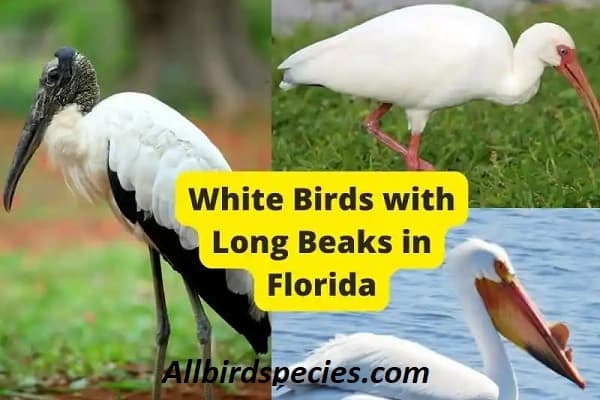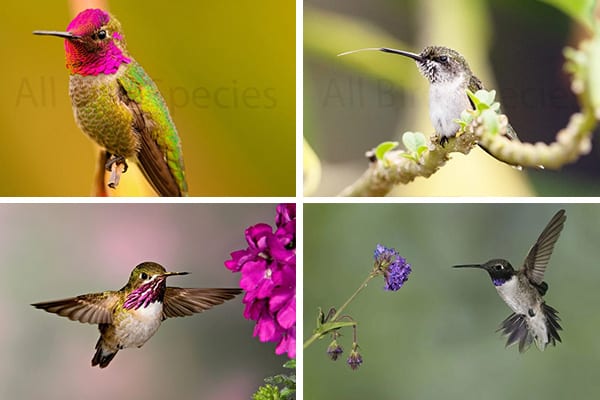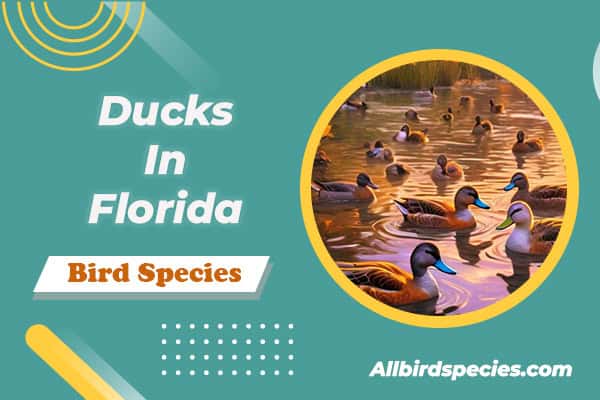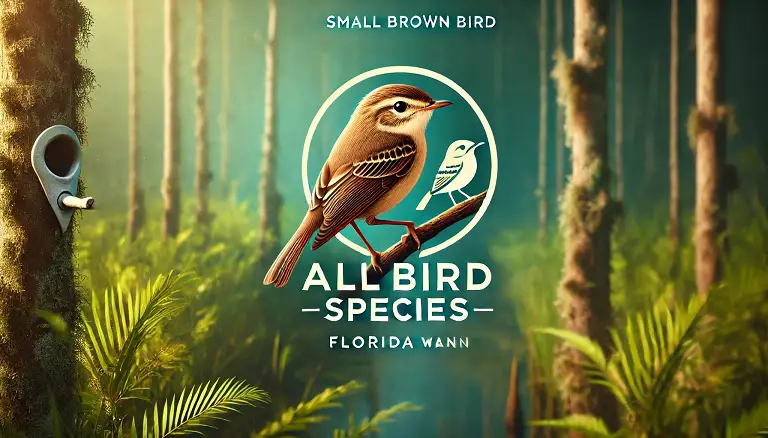9 White Birds in Florida with Long Beaks (With Photos)
I researched “White Birds in Florida with Long Beaks” and found some fascinating facts. These birds are more than just pretty; they play a key role in the ecosystem. Their long beaks are perfect for catching food in marshy areas. Want to know how they survive Florida’s unpredictable weather? Let’s dive in. You’ll discover some surprising details about these elegant creatures. Ready to explore?
Overview of White Birds with Long Beaks Found in Florida
Florida is a haven for birdwatchers, especially when it comes to spotting white birds with long beaks. These elegant creatures thrive in the state’s diverse ecosystems, from wetlands to coastal areas.
Among them are egrets and herons, known for their striking plumage and graceful movements. Their elongated bills serve critical roles in hunting and feeding along shorelines and marshes.
Ibis species also call Florida home, showcasing unique adaptations that help them forage effectively in brackish waters. The American White Pelican stands out with its expansive wingspan and distinctive bill pouch used for catching fish.
Each of these birds contributes to the rich tapestry of Florida’s avian life. Observing their behaviors can offer insights into the delicate balance of local ecosystems. Whether you’re an avid birder or a casual observer, there’s always something new to discover among these enchanting white birds.
Physical Features and Characteristics
Identifying white birds in Florida with long beaks can be a rewarding experience. Each species showcases unique features that make them stand out.
The Great Egret, for example, has strikingly slender necks and bright yellow bills. Its impressive wingspan adds to its elegance as it glides through wetlands.
Snowy Egrets are smaller and often noted for their fluffy breeding plumage and distinctive black legs. The contrast of their golden feet makes them easily recognizable amidst the reeds.
White Ibises feature curved, long bills perfect for probing mudflats. Their graceful stance is complemented by a pure white body that shines in sunlight.
The Roseate Spoonbill offers a vibrant twist with its pinkish hues alongside the classic white. Its spoon-shaped bill is not only functional but also visually captivating.
Each bird tells its own story through physical traits—observe closely to appreciate the diversity found within Florida’s avian landscape.
1. Great Egret
- Scientific Name: Ardea alba
- Size: 85–102 cm (33–40 in)
- Weight: 700–1,500 g (1.5–3.3 lb)
- Lifespan: Up to 22 years
- Diet: Fish, amphibians, small mammals
The Great Egret is a striking sight along Florida’s wetlands. With its all-white plumage and impressive wingspan, it stands tall among other birds. This heron can reach up to four feet in height, making it one of the largest wading birds in the region.

Its long neck and sharp yellow bill are perfect for hunting fish and small amphibians. The Great Egret stalks through shallow waters using stealth, often standing motionless before pouncing on unsuspecting prey.
During the breeding season, these egrets don elegant plumes that enhance their beauty even further. They gather in colonies to nest in trees or shrubs near water sources.
You might spot them gracefully flying with slow wingbeats or perched quietly against the backdrop of marsh grasses, waiting patiently for their next meal. Their serene presence adds a touch of elegance to Florida’s diverse landscapes.
2. Snowy Egret
- Scientific Name: Egretta thula
- Size: 60–66 cm (24–26 in)
- Weight: 300–600 g (0.66–1.32 lb)
- Lifespan: Up to 15 years
- Diet: Fish, crustaceans, insects
The Snowy Egret is a stunning sight, known for its pure white plumage and striking yellow feet. This elegant bird often wades gracefully through shallow waters for fish and crustaceans.
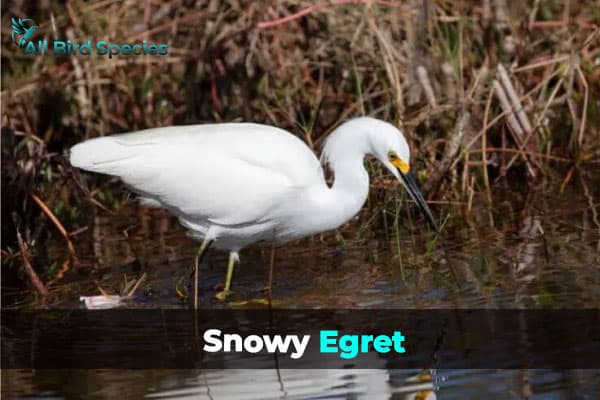
With a long, slender neck and sharp beak, the Snowy Egret is perfectly adapted for hunting. Its keen eyesight allows it to spot prey from afar, making it an efficient fisherman.
During the breeding season, these birds display their beautiful plumes that cascade down their backs. The elaborate feathers flaunt their elegance and attract potential mates.
Snowy Egrets are social creatures; they can frequently be seen foraging alongside other shorebirds or gathering in colonies during nesting periods. Their playful antics add charm to any wetland environment they inhabit.
Watching them hunt with precision is truly mesmerizing. They are a perfect blend of beauty and skill on display in Florida’s diverse ecosystems.
3. White Ibis
- Scientific Name: Eudocimus albus
- Size: 65–75 cm (25.6–29.5 in)
- Weight: 1.2–1.8 kg (2.6–4.0 lb)
- Lifespan: Up to 16 years
- Diet: Crustaceans, insects, small fish
The White Ibis is a striking bird, easily recognized by its pure white plumage and long, curved beak. This distinctive feature allows it to probe into mud and shallow waters for food. Their diet primarily consists of crustaceans, insects, and small fish.
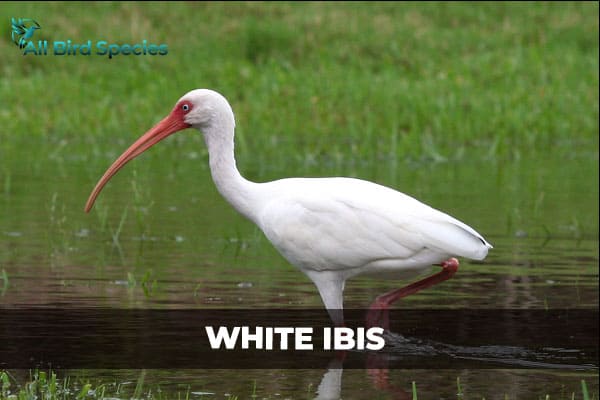
With their graceful flight, these birds often travel in groups, creating a mesmerizing sight against the blue Florida sky. You’ll likely spot them wading through wetlands or foraging near mangroves.
During the breeding season, their feathers may take on subtle hues that add to their charm. Nesting typically occurs in colonies among trees or shrubs where they can find safety from predators.
While they are not endangered, habitat loss poses challenges for the White Ibis population. Observing these elegant birds in action enhances any visit to Florida’s natural landscapes.
4. Roseate Spoonbill
- Scientific Name: Platalea ajaja
- Size: 80–90 cm (31–35 in)
- Weight: 1.2–2 kg (2.6–4.4 lb)
- Lifespan: Up to 20 years
- Diet: Small fish, crustaceans, aquatic invertebrates
The Roseate Spoonbill is a striking bird that captures attention with its vivid pink feathers and unique spoon-shaped bill. This avian beauty can often be spotted wading through Florida’s wetlands, searching for food.

With their long legs and graceful movements, these birds feed primarily on small fish and invertebrates. Their specialized bills allow them to sweep through the water, effectively locating prey by touch.
During the breeding season, they display even more vibrant colours. The contrast of their bright plumage against the blue sky creates a picturesque scene that photographers adore.
Roseate Spoonbills are social creatures, often found in colonies with other wading birds. Watching them interact adds another layer of fascination to any birdwatching excursion in Florida’s diverse habitats.
5. American White Pelican
- Scientific Name: Pelecanus erythrorhynchos
- Size: 107–180 cm (42–71 in)
- Weight: 3.6–8.2 kg (8–18 lb)
- Lifespan: Up to 16 years
- Diet: Fish, aquatic invertebrates
The American White Pelican is a striking sight against Florida’s blue skies. With its massive wingspan, stretching up to nine feet, this bird commands attention. Its pure white feathers contrast beautifully with the dark water.
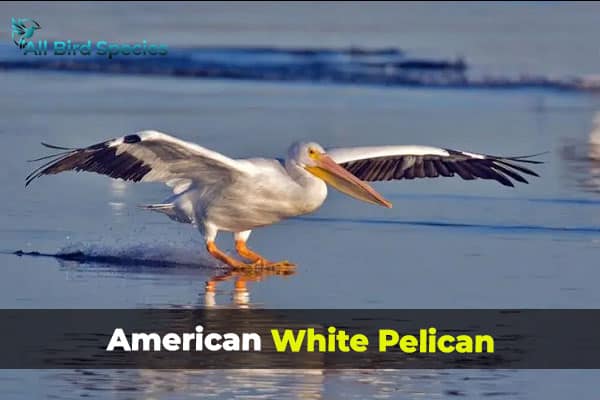
These pelicans have long, orange beaks that can scoop fish efficiently. They often feed in groups, creating a stunning display as they work together to corral schools of fish.
During breeding season, their plumage has a more regal appearance with distinctive facial pouches. The males become particularly vibrant as they show off for potential mates.
When you spot them gliding gracefully over coastal waters or nesting in colonies near lakes and estuaries, it’s hard not to appreciate their elegance and adaptability. Their presence enriches Florida’s diverse ecosystems while captivating birdwatchers and nature enthusiasts alike.
6. Wood Stork
- Scientific Name: Mycteria americana
- Size: 65–100 cm (26–39 in)
- Weight: 2.3–3.6 kg (5–8 lb)
- Lifespan: Up to 30 years
- Diet: Fish, amphibians
The Wood Stork is a remarkable sight in Florida’s wetlands. With its long, curved beak and distinctive black-tipped wings, this bird stands out among the crowd. Adult storks boast a striking white plumage that can appear almost iridescent under the sun.
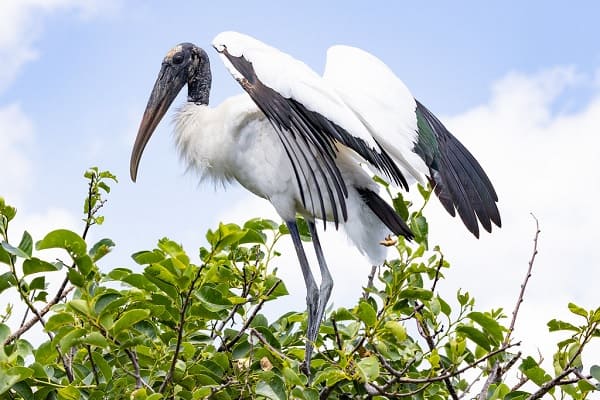
These wading birds are known for their unique feeding technique. They forage by feeling for fish and crustaceans in shallow waters with their sensitive bills. This method helps them locate prey even in murky conditions.
Wood Storks usually nest in large colonies, often alongside other waterbirds like herons and egrets. Their nests are typically built high up in trees to keep their young safe from predators.
Despite being less common than they once were, these elegant storks continue to thrive in protected areas throughout Florida. Observing them gracefully glide through the air or wade patiently along shorelines is truly captivating.
7. Tricolored Heron
- Scientific Name: Egretta tricolor
- Size: 60–70 cm (24–28 in)
- Weight: 300–500 g (0.66–1.1 lb)
- Lifespan: Up to 15 years
- Diet: Fish, amphibians, crustaceans
The Tricolored Heron is a striking bird that captures attention with its vibrant plumage. Its feathers display a beautiful mix of blue-grey and white, complemented by rich chestnut tones on the neck.
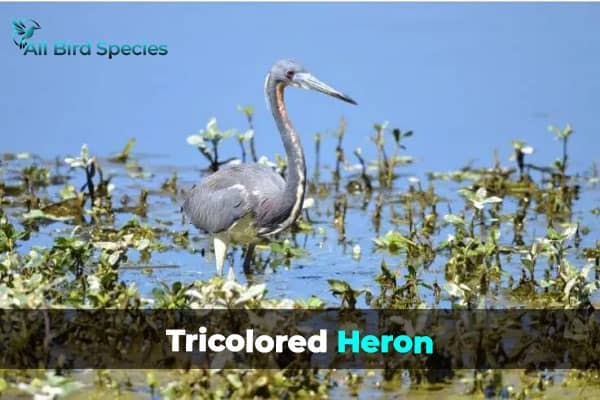
With long legs and an elongated neck, this heron moves gracefully through wetlands. It often stands still for extended periods while hunting, waiting patiently for fish or amphibians to swim into reach.
Spotting a Tricolored Heron can be thrilling. They frequent marshes, shallow waters, and coastal habitats throughout Florida. Watch for their distinct hunting style: they use quick thrusts to catch prey.
During the breeding season, these birds become even more captivating as they develop ornate plumes on their heads and backs. Their courtship displays are an elegant ballet of movement that adds charm to any wetland scene in Florida’s natural beauty.
8. Little Blue Heron
- Scientific Name: Egretta caerulea
- Size: 60–66 cm (24–26 in)
- Weight: 300–500 g (0.66–1.1 lb)
- Lifespan: Up to 10 years
- Diet: Fish, amphibians, insects
The Little Blue Heron is a striking sight in Florida’s wetlands. Its unique plumage transitions from a pure white juvenile stage to a stunning blue-grey adult hue. This colour change makes it easily recognizable among other wading birds.
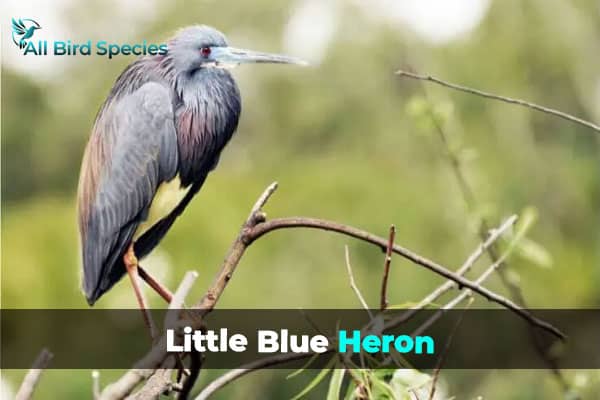
With long legs and an elongated neck, the Little Blue Heron navigates through shallow waters with grace. It primarily hunts for fish, frogs, and crustaceans, using its sharp beak to spear its prey swiftly.
These herons are known for their stealthy hunting techniques. They often stand perfectly still before making quick movements to catch their next meal. Their patience is remarkable as they wait silently for the right moment.
In flight, this bird showcases an elegant wingspan and distinctive dark colour against the sky—an unforgettable view that captivates birdwatchers and photographers alike. Spotting one can feel like finding treasure amidst Florida’s vibrant landscape.
9. Glossy Ibis
- Scientific Name: Plegadis falcinellus
- Size: 65–75 cm (25.6–29.5 in)
- Weight: 600–800 g (1.3–1.8 lb)
- Lifespan: Up to 15 years
- Diet: Invertebrates, small fish, seeds
The Glossy Ibis is a captivating bird with its striking iridescent plumage. Its feathers shimmer in shades of green, bronze, and purple, creating an enchanting effect as it moves through wetland habitats.

This White Birds in Florida with Long Beaks thrives in marshes and swamps, often foraging alongside other wading birds. It uses its long, curved beak to probe mud and shallow water for insects, crustaceans, and small fish.
With a wingspan reaching up to 28 inches, the Glossy Ibis takes flight gracefully. Their flapping wings create a mesmerizing sight against the backdrop of Florida’s blue skies.
Watching these birds is truly rewarding. They are often spotted grazing during dawn or dusk when they become most active. Keep your distance while observing to appreciate their natural behaviours without causing a disturbance.
Fun Facts and Behaviors of Each Bird
Great Egrets are known for their graceful hunting style. They can stand still for long periods, waiting patiently to strike at fish with precision.
Snowy Egrets have striking yellow feet that help them stir up prey in shallow waters. Their lively behaviour adds a playful charm to wetlands.
The White Ibis is often seen foraging in groups. These social birds use their long beaks to probe mud and sand, revealing hidden treasures like crustaceans and insects.
Roseate Spoonbills display vibrant pink feathers during mating season. Their unique spoon-shaped bills allow them to sweep through the water while they feed.
American White Pelicans are remarkable fliers, capable of soaring on thermal currents effortlessly. They often fish cooperatively, creating impressive synchronized dives.
Wood Storks rely heavily on tactile feeding. They feel vibrations in the water as they hunt for small fish and amphibians with their sensitive bills.
Tricoloured Herons exhibit a stunning mix of plumage colours, transitioning from slate blue to chestnut hues as they age.
Little Blue Herons change colour dramatically; juveniles start off white before developing deep blue plumage later on. This transformation is quite beautiful!
Glossy Ibises are social creatures that thrive in flocks but can also be found solo when searching for food among mangroves or marshes.
Tips for Spotting and Photographing These Birds
To spot white birds in Florida with long beaks, patience is key. Early mornings or late afternoons are the best times for birdwatching. These hours provide soft lighting and heightened activity.
Look near wetlands, marshes, and shorelines. These habitats attract many of these elegant creatures. Keep your distance to avoid scaring them away; a good pair of binoculars can enhance your view without intruding.
When photographing, use a zoom lens to capture detail without disturbing their space. A tripod can help stabilize your shots in low-light conditions.
Focus on natural behaviours like feeding or nesting for more dynamic images. Remember to consider the background; a clean backdrop emphasizes the bird’s beauty.
Lastly, respect wildlife regulations and ethical practices while enjoying Florida’s vibrant birdlife scene. Happy spotting!
Conservation Efforts for Protecting These Species
Conservation efforts in Florida are crucial for protecting white birds with long beaks. Various organizations, including Audubon Florida and the National Wildlife Federation, focus on habitat preservation. These groups work tirelessly to maintain wetlands and coastal areas, essential for breeding and feeding.
Education plays a vital role as well. Local communities participate in workshops that promote awareness of these species’ plights. Engaging in educational programs helps foster appreciation while encouraging responsible birdwatching practices.
Policy initiatives also contribute significantly. Legislation aimed at reducing pollution and conserving natural spaces supports healthy ecosystems where these birds thrive.
Volunteer opportunities abound, too, allowing citizens to get involved directly. Every effort, from clean-up events to citizen science projects, counts toward sustaining their populations.
Protecting these magnificent birds requires collaboration among conservationists, policymakers, and the public alike. By working together, we can ensure future generations enjoy the beauty of Florida’s avian wonders.
Read More🐦Related Articles:
- Orange Butterfly Meaning
- Black Birds in Michigan
- Finches in Michigan
- inches In Hawaii
- Birds With Red Beaks
- Spiders in California
Conclusion
Florida is a paradise for bird lovers. The diverse range of habitats provides an ideal setting for spotting various species, especially the stunning white birds with long beaks that grace its wetlands and shorelines. Each bird has unique features that make them special, from the elegant Great Egret to the striking Roseate Spoonbill.
Exploring Florida’s natural landscapes offers endless opportunities to observe these magnificent creatures in their native environments. Whether you’re an avid photographer or simply enjoy watching wildlife, take time to visit local parks and reserves where these birds thrive.
With patience and keen eyes, you can witness their behaviours up close—whether they’re hunting for fish or socializing with other birds. Don’t forget your camera; capturing images of these graceful flyers makes for lasting memories.
As you embark on your journey through Florida’s rich avifauna, remember to respect their habitats and contribute to conservation efforts to protect these beautiful species. Every visit adds value not just to our understanding but also supports initiatives that keep these enchanting birds thriving in the wild.
So grab your binoculars and head out into Florida’s vibrant ecosystems! There’s always something new waiting around the corner, ready to inspire awe in anyone who notices.

